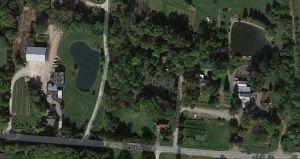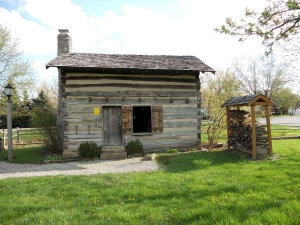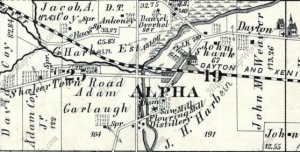Book
Are you as SICK of the stink bug invasion of Beavercreek as we are?! HATE THEM!! I think we were all hoping that our miserable winter would have taken care of them... but research and reality is proving that to not be the case. Rob Venette, a Forest Service Research Biologist reports that temperatures must reach -20°F to even faze them (nor the dreaded Emerald Ash Borer). So what we've experienced is a little correction that may have thinned their ranks, but as the warm weather returns - so are they.
So what can you do?
We have a GREAT FUTURE in Beavercreek, short term and on the horizon! Spirits are high, new businesses and restaurants are opening, homes are selling and our community is booming! We're looking forward to a number of exciting projects...
Community
- The McAfee Sports Center - Two generations of youth have learned the joy of athletics through Beavercreek Stars basketball at Henley Hall.
Just across I-675 on the north side of the road is the home at 4308 Kemp Road recently known as Frank’s Fruit Farm. This property, which used to extend all the way east to Spinning Road, was a large-scale dairy farm owned by Jake Shellabarger (1857-1942), the namesake of nearby Shellabarger Park. Jake purchased the home and 93 acres from Jonathan Harshman.
Most small farms had dairy cows to provide milk for the families, but lacked the capacity to process and market dairy products. Often, they'd sell their excess to larger local dairy operations, like the Shellabarger Dairy, to be processed, packaged and sold.
At the point where Kemp Road dips the lowest, glance to your right. The red barn with the black roof was the winter home of circus animals that performed at the Montgomery County Fairgrounds and throughout the Midwest! Note the taller opening for the elephants.
Please turn around at the top of the hill by turning left onto Entrada Drive, former location of the Saville home, and then returning east on Kemp Road.
https://beavercreekliving.com/book/itemlist/user/23-brettwilliford?start=160#sigProIdd9eb526716
Drive south (left) on Grange Hall Road. At the southwest corner of Grange Hall Road and Pentagon Boulevard is where the Nicodemus cabin was discovered in 1976 and subsequently moved to Wartinger Park. Insect infestation ultimately caused its removal from the park, but a replica was built using the original fireplace. The original structure was likely built by a member of the Hotopp (Hoetopp) family.
Continuing south, we bisect the 158 acres of the Solomon Snypp property and turn west onto Kemp Road, named for Jacob Kemp. On the north side of the road near the site of 3962 Kemp Road sat the second Aley School #3. Across the street near 2237 LaGrange Road was the Ealy (Aley) blacksmith shop. Further west is Aley Church, founded in 1838 by Jacob Aley. The smaller building at the west end of the parking lot was second church, built after a fire consumed the first. Just west of the church at 2100 Wagner Trace Drive lies the former Abraham Hawker Estate which encompasses the current Wagner Trace and Summerfield Village neighborhoods.
https://beavercreekliving.com/book/itemlist/user/23-brettwilliford?start=160#sigProIdcfb1d04058
In town in the mid-1800’s you’d have found a General Store and blacksmith shop as well as the pictured New Germany School #11, which burned down in February 1920 while the teacher and pupils were eating lunch - no reported injuries. Much of the land in 1874 was owned by members of the Harshman Family.
During the early twentieth century, the social lives of those in northern Beavercreek Township revolved around New Germany Hall, famous for their 50/50 dances - 50% round dancing and 50% square dancing. The Hall clothing store was also a popular local shopping destination.
If you continued west northwest through Wright Patterson Air Force Base, you would have found yourself in a town known as Harshmanville, found opposite the National Museum of the United States Air Force (and their AWESOME virtual tours) on Springfield Street. In the late 1800’s the Gerlaugh, Zink, Glaser, Barr, Kraft & Bates families were prevalent.
Our geographic neighbor, Fairborn, has a truly unique story of how it ‘came together’! There’s a short documentary describing how the towns of Fairfield and Osborn became Fairborn.
https://beavercreekliving.com/book/itemlist/user/23-brettwilliford?start=160#sigProId6f4410ccd6
 Our tour begins at 2800 New Germany-Trebein Road – formerly the 112 acre farm of J.L. Lantz and currently The Beavercreek Golf Club. The 1855 farms of Sam Brown, Edward Tobias, George Harner and Henry Ankeney were cut from the rolling, densely wooded hills of this area known as ‘The Big Woods’.
Our tour begins at 2800 New Germany-Trebein Road – formerly the 112 acre farm of J.L. Lantz and currently The Beavercreek Golf Club. The 1855 farms of Sam Brown, Edward Tobias, George Harner and Henry Ankeney were cut from the rolling, densely wooded hills of this area known as ‘The Big Woods’.
Born in 1919, lifelong Beavercreek resident Ruth Booher-Stafford recalled young ladies from around her home near Alpha sneaking away from home to attend parties in 'The Big Woods' area. Often, to the embarassment of their parents, they'd be stranded overnight due to the treacherous route and extreme darkness of the journey back home again.
As you exit Golf Club Boulevard, the green to your left was the approximate location of the Rudisell blacksmith shop, one of over a dozen throughout the township. We’ll soon turn west toward N. Fairfield, but at the crest of the hill to your left was the location of the Harshman-Walters Cabin. This was the oldest structure in Beavercreek until destroyed by fire during restoration on November 23, 2004. Thought to have been originally owned by a member of the Harshman family, it was a 19’x17’ log building with a loft containing a porthole to lookout for Indians. It is believed that it had also been a toll gate house, which is how funding was raised to clear timber and construct roads.
Much of history is documented in obituaries and on headstones. Beavercreek has numerous cemeteries, large and small. One of the smaller, quaint ones is located just to the north of here off of Pascal Drive. A few images of the Reese-Petro cemetery follow...
https://beavercreekliving.com/book/itemlist/user/23-brettwilliford?start=160#sigProId78d268a6a1
1961 Description of Zimmerman - Zimmermansville about two miles west of Alpha on the Old Dayton and Xenia Pike had a blacksmith shop, grocery, school house and two Dunkard Churches. The railroad station is a quarter of a mile south of Zimmerman and is named Shoup’s Station.
Present Day - You’ll notice there’s no town of Beavercreek! The area generally referred to as ‘downtown’ was known as Zimmermansville. Later it was shortened to Zimmerman, and often called “Push on” for various, but unconfirmed reasons. Whether it was the train conductors asking riders if they were exiting the train at Shoup’s Station (near the 9-11 Memorial) or going to “Push on” to the next stop or earlier travelers between Dayton and Xenia stopping to water their horses prior to “Pushing On” to their destination – the name stuck.
The community was centered on the intersection of Dayton-Xenia Road and North Fairfield Road, but the mills and train station were to the south at the bottom of the hill near the location of the current Daytona Mill and Beavercreek Station on the Creekside Trail.
1961 Description of Trebein - Trebein formerly known as Pinkneyville, Frost Station and Beaver Station is two miles nearer Xenia. Pinkney Road running from Cincinnati through Bellbrook, through Trebein, through Oldtown and into Xenia was a very busy thoroughfare in the 1800’s, bringing supplies to and from Cincinnati. William Maxwell, first printer and publisher in the Northwest Territory lived near Trebein and is believed to be buried about a mile southwest of Trebein on a knoll just back of his cabin.
Present Day - Trebein was another cross-road town on the rail line between Alpha and Xenia. A series of mills were built, the first by Adam Emory. Jonathan Snyder built a distillery in 1841 and found the production of whiskey to be quite profitable. Corn grown during the time was intended to feed livestock and truly wasn’t eaten in kernel form. Excess was distilled into whiskey and used to supplement income.
Later named for another businessman, F.C. Trebein, the small town offered a mill, a larger distillery and a fertilizer factory. A few homes and the remnants of some industrial sites still remain. Until the mid-1990’s the area was still known for its one-lane bridge over the Little Miami River.
1961 Description of New Germany - New Germany in the northwest corner of the township was a settlement of farmers of German extraction. It has two blacksmith shops, two grocery stores, dry goods store, a saloon, a school house and an Old Stage Coach Inn. The main thoroughfare running from Cincinnati through Dayton, Fairfield, Springfield and Columbus, passed through New Germany using the Old Stage Coach Inn as a stopping place. New Germany had a band organized in 1896, which played at political rallies, picnics and many other places where they were in demand.
Present Day - The town of New Germany has been consumed by progress, but its remnants are still there to see. Located at the current intersection of Colonel Glenn Highway and Grange Hall/National Road, a portion of the land is now Federal property allocated to WPAFB, other portions have become part of the Meijer Superstore and the business park adjacent to Home Depot.
Many of the streets indicated on the inset map are still there, and homes from the 1930’s and 1940’s can still be found along National Road and Germany Lane. Colonel Glenn Highway was formerly known as Zink Road and boomed as Dayton’s “Third Street Extension”.
A Collection Of Small Towns...
1961 Description of Alpha - Mr. John Harbine and Mr. Needles laid out the town of Alpha in 1854. When what is now the Pennsylvania railroad was built, Mr. Harbine gave land required and the station was named Harbine. It was a lively manufacturing center with its distillery, flour, cotton, woolen, grist, saw and oil mills, and did a large tobacco, grain, and shipping business to all parts of the country. From the first mill and the first barrel of flour which was marked "Alpha" the name has clung to the place. There are in the town a nice brick church, a school, a post office, coal office, two stores and at upper Alpha a K of P Hall, a blacksmith shop and Beavercreek Township High School built in 1888. The waters of Beaver Creek have turned the wheels of grist mills for more than a century and the old dam and old covered bridge torn down recently is an attractive place for picnics, fishing and swimming parties, but the block houses, mills, and store houses are no longer to be seen and the valley is peaceful, productive and beautiful.
Present Day - Alpha really became the hub of activity in Beavercreek Township. With its numerous mills and famous “panhandle” railroad lines running through town, industry was thriving for over 100 years! John Harbine (pictured, sometimes spelled Harbein) wasn’t the first businessman to prosper in Alpha, but he was the first to genuinely industrialize the town and literally had his hand in most aspects of business in the town including the original surveying and parceling. Mr. Harbine’s businesses included a saw mill, grist mill, flouring mill, an oil mill, and even a distillery! More on this later…
Throughout this work you’ll learn of Alpha’s memorable residents: Dr. Anderson, the town blacksmith - Charley Johannes, the General Store keeper – Mr. Needles, and even a notable villain named Justice! Alpha retains a great sense of pride with its own museum, grain elevator and the best post office in the county!
https://beavercreekliving.com/book/itemlist/user/23-brettwilliford?start=160#sigProIde1bc1f7bd0
Navigation
Latest Blog Posts
- Just Don't Call Us Late For Dinner...
- Remember When...
- What A Long, Strange Trip It's Been...
- Snow Down = Slow Down
- School Bus Safety - Just Do It!
- Stevenson Road Covered Bridge
- Our Road Crews Are Worth Their Salt!
- The Most Colorful Of Seasons!
- Popcorn Fest! - Then And Now
- Pre-School Paradise!
- Remembering Riffles
- Ten Year Anniversary Of The Beaver Statues















